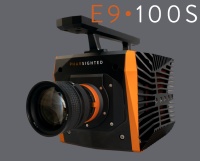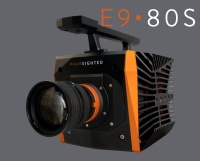- Description
- Specifications
The Shimadzu HyperVision HPV-X2 has recording speed of 10 million frames per second, the highest in its class with larger, clearer, high-sensitivity recording. The HPV-X2 is equipped with synchronized recording function, and high-level analytical capabilities that accommodate a variety of software programs
Visualization technology is one of the driving forces behind progress in science and technology. Medical science and engineering have made dramatic progress thanks to visualization technology. Examples include the invention of microscopes capable of enlarged observations of phenomena occurring in the microscopic domain, invisible to the human eye, X-ray inspection systems, which enable the observation of images utilizing light at imperceptible wavelengths, and infrared cameras.
Our eyes are incapable of capturing phenomena occurring at times shorter than 50 to 100 ms. As a result, high-speed video cameras have become necessary in order to record phenomena occurring at intervals that cannot be seen with the human eye, and then replay them at a slower rate so that they can be visualized.
As the standard tool for visualizing ultra high-speed domains, the Hyper Vision high-speed video camera contributes to our understanding of ultra high-speed phenomena in a variety of fields.
| 400x250 @ 5m fps | |
|
Burst Method Enables Ultra High-Speed Recording For typical high-speed video cameras, image storage memories are located outside of the image sensor. Because the number of signal output taps are overwhelmingly small compared to the number of pixels, the transfer of the video signals from the pixels to the memories must be a sequentially serial process; therefore, ultra high-speed recording of more than 1 million frames per second could not be realized. In contrast, Shimadzu's burst image sensor has the same number of built-in memories as number of frames recorded. Furthermore, a pixel and memories are connected by wire in a one-to-one manner in order to completely parallel transfer the video signal from the pixels to the memories. This makes it possible to realize ultra high-speed recording at 10 million frames per second. In addition, since it not limited to the number of signal output taps as with conventional serial transfer system, high-resolution recording at ultra high speed is available.
Next-Generation Burst Image Sensor Based on CMOS Technology Conventional burst image sensors are based on CCD technology, in which the memory is positioned adjacent to the pixels. As a result, there are problems with decreased image quality due to signal leakage from pixels to memory. Accordingly, the Shimadzu FTCMOS burst image sensor adopts CMOS technology, in which the pixels and memory are spatially separated to achieve high image quality with no signal leaks. In addition, with the FTCMOS2, light sensitivity is six times better than with FTCMOS, thanks to the adoption of a new CMOS process.
|
|
| 128 - 256 frames | |
| 10,000,000fps | |
| @10Mfps fixed to 50ns | |
| Variable recording speed between 60 fps and 2 Mfps (in 1/10 ns steps) | |
| Gigabit Ethernet | |
| 10-bit | |
| No | |
| 256 frames @ 10m fps | |
| FTCMOS2 image sensor |
Related products
Export Disclaimer: Some goods on this site may be subject to US Export Regulations. Buyer agrees as one of the terms of purchase not to export such goods without having obtained and executed proper export licenses from the United States Government. Learn more.








